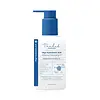What's inside
What's inside
 Key Ingredients
Key Ingredients

 Benefits
Benefits

 Concerns
Concerns

No concerns
 Ingredients Side-by-side
Ingredients Side-by-side

Water
Skin ConditioningDipropylene Glycol
HumectantGlycerin
HumectantButylene Glycol
HumectantDecyl Glucoside
CleansingCoco-Glucoside
Cleansing1,2-Hexanediol
Skin ConditioningAcrylates/C10-30 Alkyl Acrylate Crosspolymer
Emulsion StabilisingHydroxyacetophenone
AntioxidantTromethamine
BufferingXanthan Gum
EmulsifyingGlyceryl Acrylate/Acrylic Acid Copolymer
HumectantDisodium EDTA
Hydrolyzed Hyaluronic Acid
HumectantPolyquaternium-51
Skin ConditioningSimmondsia Chinensis Seed Oil
EmollientWater, Dipropylene Glycol, Glycerin, Butylene Glycol, Decyl Glucoside, Coco-Glucoside, 1,2-Hexanediol, Acrylates/C10-30 Alkyl Acrylate Crosspolymer, Hydroxyacetophenone, Tromethamine, Xanthan Gum, Glyceryl Acrylate/Acrylic Acid Copolymer, Disodium EDTA, Hydrolyzed Hyaluronic Acid, Polyquaternium-51, Simmondsia Chinensis Seed Oil
Water
Skin ConditioningGlycerin
HumectantDipropylene Glycol
HumectantSodium Cocoamphoacetate
CleansingPotassium Cocoyl Glycinate
Lauryl Glucoside
CleansingPolyglyceryl-6 Caprylate
EmulsifyingCoco-Glucoside
Cleansing1,2-Hexanediol
Skin ConditioningLauryl Hydroxysultaine
CleansingAcrylates Copolymer
Sodium Chloride
MaskingDisodium Cocoamphodiacetate
CleansingMaltodextrin
AbsorbentPPG-7
Skin ConditioningLactobacillus Ferment Lysate
Skin ConditioningParfum
MaskingButylene Glycol
HumectantDisodium Cocoyl Glutamate
CleansingArgania Spinosa Kernel Oil
EmollientSaponins
CleansingEthylhexylglycerin
Skin ConditioningArginine
MaskingAspartic Acid
MaskingGlutamic Acid
HumectantTetrasodium EDTA
Acrylates/Stearyl Methacrylate Copolymer
Emulsion StabilisingCollybia Mushroom Extract
Hyaluronic Acid
HumectantXanthan Gum
EmulsifyingDisodium EDTA
Ceramide NP
Skin ConditioningTocopherol
AntioxidantWater, Glycerin, Dipropylene Glycol, Sodium Cocoamphoacetate, Potassium Cocoyl Glycinate, Lauryl Glucoside, Polyglyceryl-6 Caprylate, Coco-Glucoside, 1,2-Hexanediol, Lauryl Hydroxysultaine, Acrylates Copolymer, Sodium Chloride, Disodium Cocoamphodiacetate, Maltodextrin, PPG-7, Lactobacillus Ferment Lysate, Parfum, Butylene Glycol, Disodium Cocoyl Glutamate, Argania Spinosa Kernel Oil, Saponins, Ethylhexylglycerin, Arginine, Aspartic Acid, Glutamic Acid, Tetrasodium EDTA, Acrylates/Stearyl Methacrylate Copolymer, Collybia Mushroom Extract, Hyaluronic Acid, Xanthan Gum, Disodium EDTA, Ceramide NP, Tocopherol
 Reviews
Reviews

Ingredients Explained
These ingredients are found in both products.
Ingredients higher up in an ingredient list are typically present in a larger amount.
1,2-Hexanediol is a synthetic liquid and another multi-functional powerhouse.
It is a:
- Humectant, drawing moisture into the skin
- Emollient, helping to soften skin
- Solvent, dispersing and stabilizing formulas
- Preservative booster, enhancing the antimicrobial activity of other preservatives
Butylene Glycol (or BG) is used within cosmetic products for a few different reasons:
Overall, Butylene Glycol is a safe and well-rounded ingredient that works well with other ingredients.
Though this ingredient works well with most skin types, some people with sensitive skin may experience a reaction such as allergic rashes, closed comedones, or itchiness.
Learn more about Butylene GlycolCoco-Glucoside is a surfactant, or a cleansing ingredient. It is made from glucose and coconut oil.
Surfactants help gather dirt, oil, and other pollutants from your skin to be rinsed away.
This ingredient is considered gentle and non-comedogenic. However, it may still be irritating for some.
Learn more about Coco-GlucosideDipropylene Glycol is a synthetically created humectant, stabilizer, and solvent.
This ingredient helps:
Dipropylene glycol is technically an alcohol, but it belongs to the glycol family (often considered part of the ‘good’ alcohols). This means it is hydrating and gentle on skin unlike drying solvent alcohols like denatured alcohol.
As a masking agent, Dipropylene Glycol can be used to cover the smell of other ingredients. However, it does not have a scent.
Studies show Dipropylene Glycol is considered safe to use in skincare.
Learn more about Dipropylene GlycolDisodium EDTA plays a role in making products more stable by aiding other preservatives.
It is a chelating agent, meaning it neutralizes metal ions that may be found in a product.
Disodium EDTA is a salt of edetic acid and is found to be safe in cosmetic ingredients.
Learn more about Disodium EDTAGlycerin is already naturally found in your skin. It helps moisturize and protect your skin.
A study from 2016 found glycerin to be more effective as a humectant than AHAs and hyaluronic acid.
As a humectant, it helps the skin stay hydrated by pulling moisture to your skin. The low molecular weight of glycerin allows it to pull moisture into the deeper layers of your skin.
Hydrated skin improves your skin barrier; Your skin barrier helps protect against irritants and bacteria.
Glycerin has also been found to have antimicrobial and antiviral properties. Due to these properties, glycerin is often used in wound and burn treatments.
In cosmetics, glycerin is usually derived from plants such as soybean or palm. However, it can also be sourced from animals, such as tallow or animal fat.
This ingredient is organic, colorless, odorless, and non-toxic.
Glycerin is the name for this ingredient in American English. British English uses Glycerol/Glycerine.
Learn more about GlycerinWater. It's the most common cosmetic ingredient of all. You'll usually see it at the top of ingredient lists, meaning that it makes up the largest part of the product.
So why is it so popular? Water most often acts as a solvent - this means that it helps dissolve other ingredients into the formulation.
You'll also recognize water as that liquid we all need to stay alive. If you see this, drink a glass of water. Stay hydrated!
Learn more about WaterXanthan gum is used as a stabilizer and thickener within cosmetic products. It helps give products a sticky, thick feeling - preventing them from being too runny.
On the technical side of things, xanthan gum is a polysaccharide - a combination consisting of multiple sugar molecules bonded together.
Xanthan gum is a pretty common and great ingredient. It is a natural, non-toxic, non-irritating ingredient that is also commonly used in food products.
Learn more about Xanthan Gum